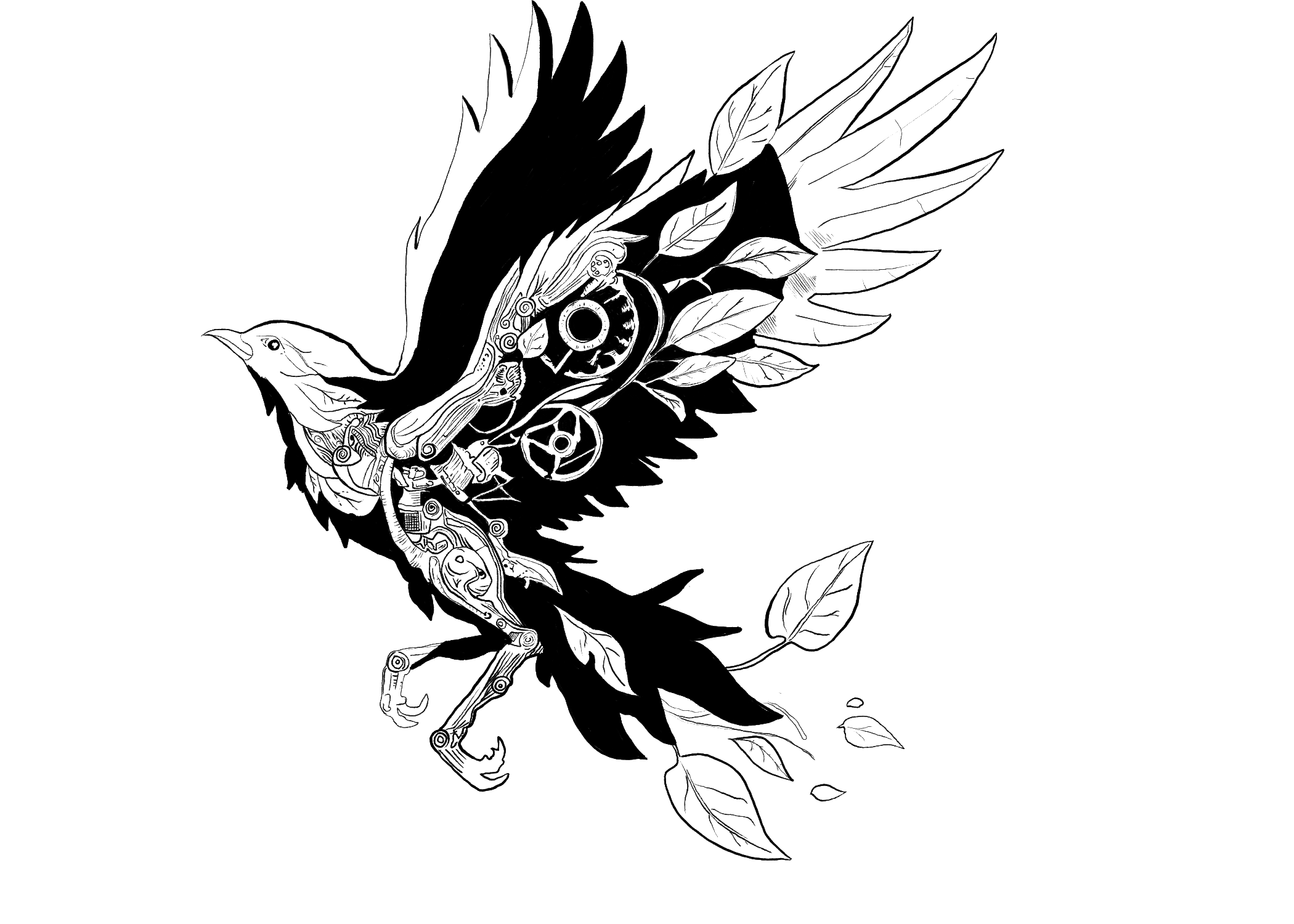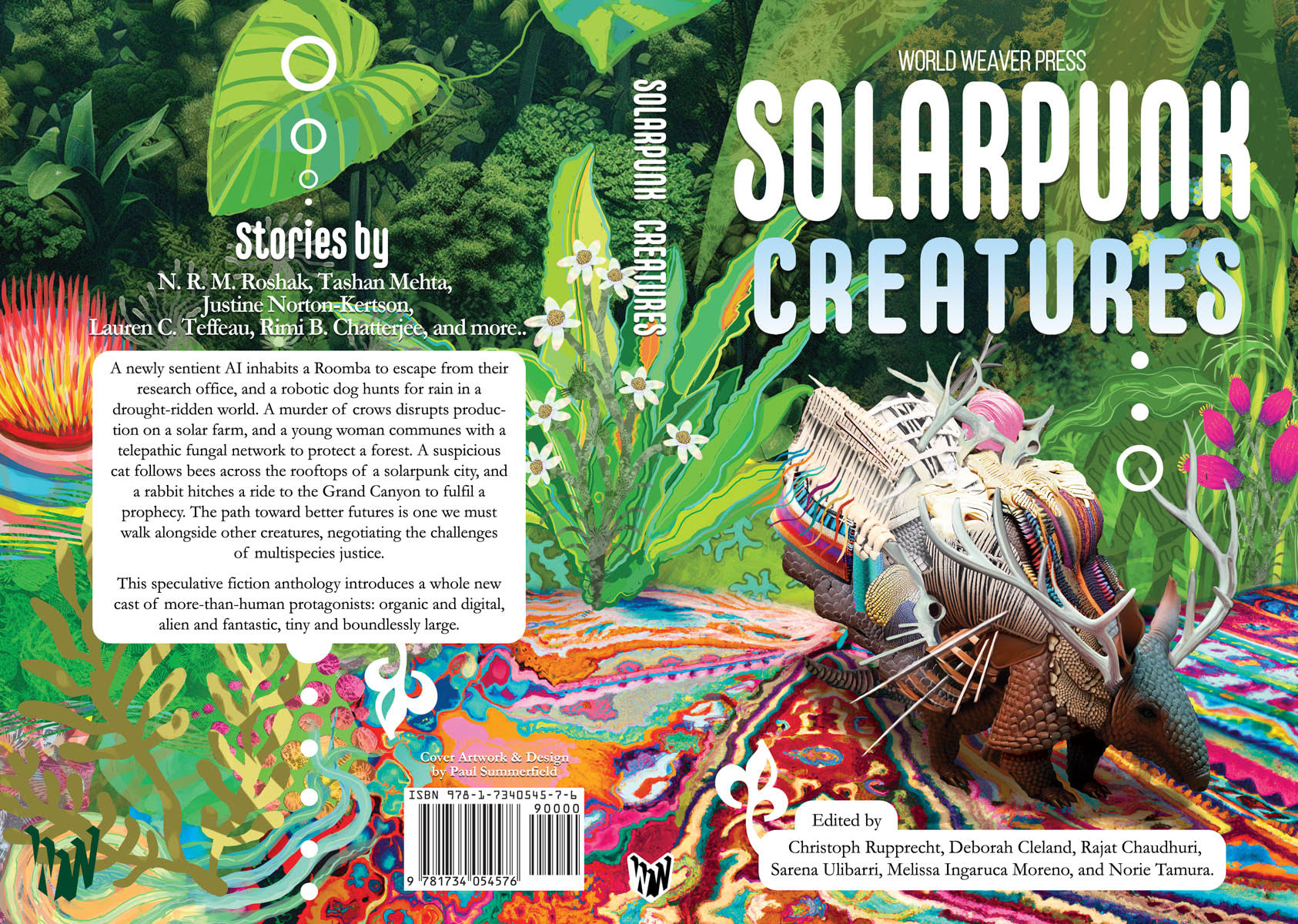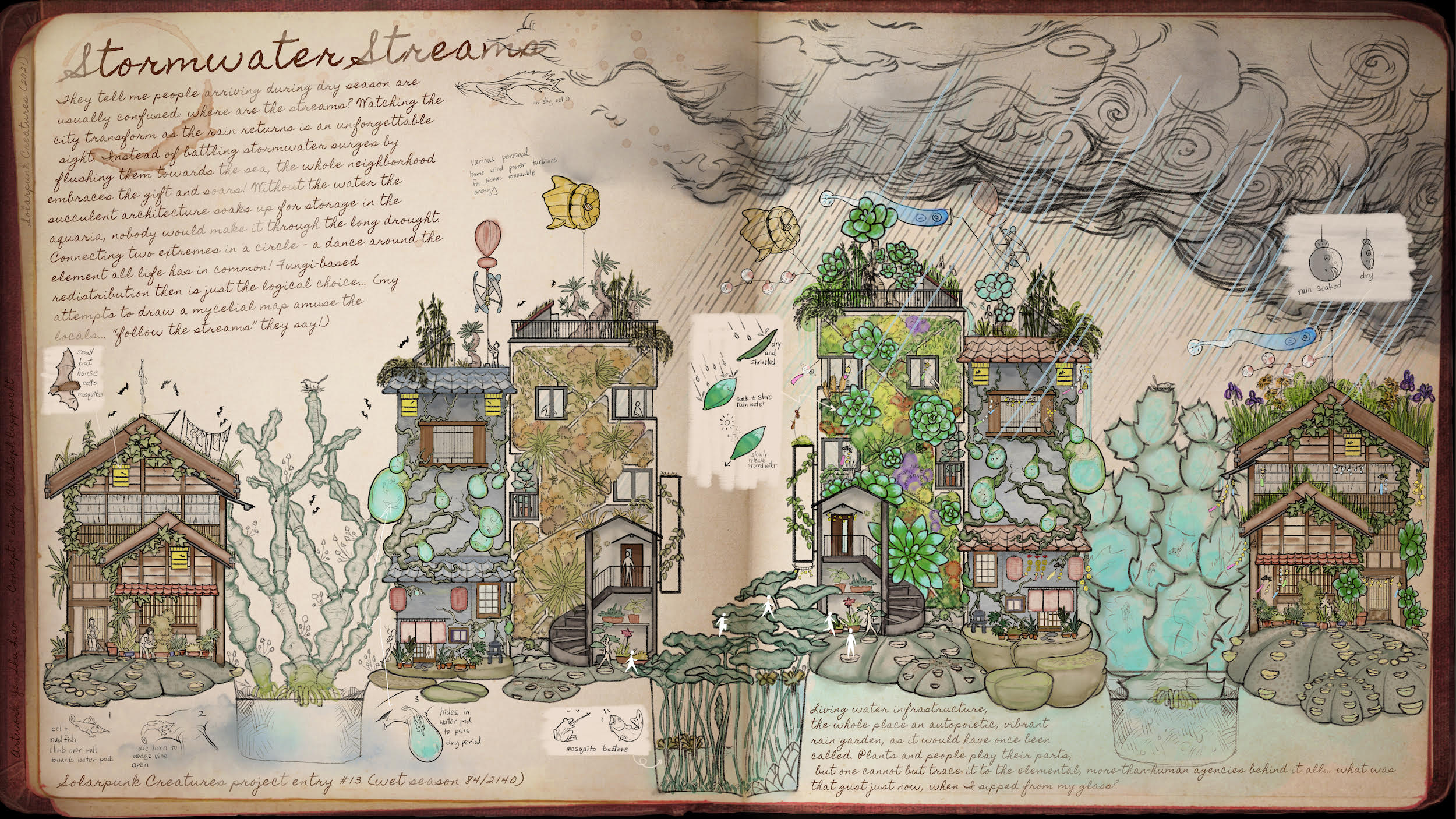Alife News
The Artificial Life Community Newsletter

A Word from the Team
Welcome to the 16th issue of the Alife Newsletter! The theme for this newsletter is Solarpunk. Many of us have grown up on "Cyberpunk" -- an aesthetic that imagines the negative runaway effects of technology and capitalism on society. Now that, in true Torment Nexus style, many of those predictions are coming to tuition, a new aesthetic comes up to imagine how we can break into a future where nature, sustainable tech, and society can collaborate with each other.
With this new image in mind, we bring a review of the science fiction books "Solarpunk Creatures", and "The Kaiju Preservation Society". We also highlight a link to the "Solarpunk Conference".
Other news in this newsletter include the new discord servers for the Artificial Life community organized by the International Society of Artificial Life (ISAL); New episodes on Imy's podcast, "What ALife!"; a call for projects from the UKRI; and an online workshop of universal communication from Crosslabs. We also mourn the passing of Daniel Dennet, with an Eulogy from Dave Ackley.
If you have any suggestions for future content, or would like to help us edit the newsletter, you can leave us a message in the feedback form. We specially appreciate messages from Master and PhD students who want to talk about their recent work. Send us a line! If you got something to share that other Alifers would be interested in, we want to know about it!
Lana, Imy, Mitsuyoshi, Claus and Gabriel
- Discord Servers for the Artificial Life Society
- WhatALife! Podcast
- Solarpunk: Nature and Tech
- Solarpunk conference 2024: Rays of Resilience
- Book Reviews: Imaginary Lifecycles
- Are Boids the future of self-driving cars?
- $100m UKRI Investment in Future AI Hubs
- Rest In Peace, Daniel Dennett
- Workshop Summary: The Quest for Universal Communication
- About the Artificial Life Newsletter
Discord Servers for the Artificial Life Society
by Claus
The International Society for Artificial Life (ISAL), has created a general discord server for discussing matters of interest to the Artificial Life community.
You can join the discord server using this link. It is worth noting that this is the ALIFE 2023 server modified, so if you have joined the ALIFE 2023 server, you are automatically a member of the ISAL official server.
Join us and let's get a good conversation going!
Also, a reminder that the "Emerging Researchers in Alife" (ERA) community also has a discord server has has been running for a while, is active and a source of discussion and support for students and early career researchers. You can join the ERA discord server using this link.
WhatALife! Podcast
by Imy Khan
...as if we needed any more podcasts in the world! But hey, I suppose we can't have too much ALife content, right?
After much deliberation and procrastination, I finally organised myself to get the WhatALife! Podcast off the ground. The podcast aims (primarily) to serve as a sort-of outreach endeavour for Artificial Life as a field and community: breaking down some of the complexities of ALife topics, methods, and ongoing research, and making ALife more accessible to the masses.

The podcast can be found on several streaming platforms (Spotify, Amazon Music, Google Podcasts). I'm still working on getting it on to the remaining platforms (including Apple!).
RSS: https://anchor.fm/s/f21938c0/podcast/rss.
At the time of writing, we are three episodes in - discussing cellular automata, theories of agency, and life as an early career researcher in the modern world - and we aim to have another episode out every few weeks. If you have any comments or suggestions for future episodes, or any feedback about the show, please send me an email at podcast@imytk.co.uk. If you would like to join me for a conversation on the podcast (or have suggestions for anyone who might be interested), please also feel free to write to me.
Artwork was created by our very own Gabriel J. Severino!
Solarpunk: Nature and Tech
Shared by Lana Sinapayen
You may have come in contact with the idea of Solarpunk, through scifi books or video games, maybe even wihout realizing it! Solarpunk envisions a future beyond capitalism, where humans use tech to live without overexploiting nature. In this series of talks shared by the Solarpunk Now! podcast, panelists from the Solarpunk Conference share their visions of exiting capitalism and bringing solarpunk to the real world.
"From Capitalist Realism to a Solarpunk Reality: Building the Infrastructures of a Better Future"
Book: Speculative fiction anthology “Solarpunk Creatures"
What would coexisting with all forms of life be like? Three years have passed since our first anthology, “Multispecies Cities: Solarpunk Urban Futures”, set out to tell stories of more-than-human urban coexistence and kinship. Facing climate change, the sixth mass extinction, late-stage capitalism, and colonisation, yet refusing to surrender our entangled futures to despair, our contributing authors imagined worlds where people meet new allies of all shapes, sizes, and species. Exploring these worlds left us to wonder: who are these new allies? What are their stories? What post-anthropocene futures might more-than-human senses discover? Where “Multispecies Cities” sought to broaden the spotlight and highlight the multitude of actors on the stage, our next speculative fiction anthology “Solarpunk Creatures” introduces a whole new cast of more-than-human protagonists: organic and digital, alien and fantastic, tiny and boundlessly large.
Solarpunk Creatures features 20 stories and 8 artworks and is available since January 2024 as an ebook or paperback with color art directly from World Weaver Press or any bookshop.

Cover art: Paul Sommerfield

Featured artwork: “Stormwater Streams (Connectedness)” (Art: Yen Shu Liao, Text: Christoph Rupprecht
Solarpunk conference 2024: Rays of Resilience
Shared by Lana Sinapayen
We thought the timing was perfect to share this event along with the Solarpunk book entry! The conference will take place online on June 29th. Propose a talk, get your tickets and buy goodies at https://www.solarpunkconference.com/.
Book Reviews: Imaginary Lifecycles
By Mitsuyoshi
In this section, I present books that feature creatures with imaginary lifecycles.
“The dragon's final home” by Kotaro Tsunekawa
The dragons in this story are born as tiny tadpole-like creatures in the water and grow through metamorphosis. Only a handful of the thousands of juveniles survive to grow into the giant dragons that stand at the top of the ecosystem. For dragons, the process of development is both a climb up the pyramid of the food chain and a broadening of horizons. An aquatic creature that lived only in ponds becomes an amphibian, then a land-walking lizard, and finally a dragon that acquires wings and migrates from island to island.
As the (dragon) protagonist grows up, he sees that many of his own kind have ceased to continue their development and instead have chosen to live in the forms of fish, amphibians, or lizards. He learns that when their development stalls, their bodies stop growing, and at the same time, the extent of their behavior and status in the ecosystem becomes fixed.
When you cease your development, your status becomes fixed and you are looked down upon by your kin who have continued in their development... This is a metaphor for human growth in school and society, but the vivid depiction of it as the life cycle of a fictional creature, the dragon, is what draws us into this story.
“Orthogonal” series by Gregg Egan
The Orthogonal trilogy depicts a world in which the laws of physics are slightly different from those of our world. The name of the series, “Orthogonal”, refers to its orthogonal physics and the kind of world that such a system would produce. Within this alternate system, we are introduced to the ecology of the “humans” who appear in this world.
The “humans” of this world, like other creatures, procreate by an ancestor dividing its body to produce multiple descendents. In other words, it is not possible for the mother to see her own children, as she instead splits her body and becomes them. In creatures with such a lifecycle, the gender roles are biologically determined, with the female passing on the temporarily borrowed flesh of the mother to the next generation through the creation of offspring. Males raise their young.
This gender role can be derived from the simple observation that: - A “mother” can procreate without a father. - The species that allows children to be active from the moment of birth does not produce fathers.
The story describes how people with distinct gender roles live and how science is developed to free people from their natural gender roles.
“Kaiju Preservation Society” by John Scalzi
In this story, there is a “monster” the size of a mountain! There is only one energy source that can drive a creature of that size. A biological reactor.
Kaiju species live one of two lifecycles. The life cycle in which they do not obtain a reactor, and live their entire life as chemo-metabolizing titanotheres. The other is the lifecycle of a kaiju, in which the development of a nuclear reactor paves the way for its growth into a giant kaiju.
In addition to the interesting science fiction aspect of the ecology of a reasonable fictional life, it is also interesting to think about what kind of world setting could encompass such an ecology from the perspective of artificial life.
Are Boids the future of self-driving cars?
Shared by Lana
Probably not, but in this viral video taking swings at the broken promises of self-driving cars, boids make a surprise appearance that took me off-guard. How many decades-old ALife models can still invoke such a feel of wonder that they show up as an alternative to Tesla?
Watch here: https://youtu.be/2DOd4RLNeT4?si=_o8uC2Sajj9oGnVQ&t=1277
$100m UKRI Investment in Future AI Hubs
Written by Imy Khan
The UK Research and Innovation (UKRI), through the Engineering and Physical Sciences Research Council (EPSRC) has invested almost $100 million USD into nine dedicated research hubs in the UK, focusing on tackling complex societal problems through what it calls "revolutionary and innovative AI".
While these buzzwords might make some of you roll your eyes, the scope of the research appears to be fairly broad and overlaps with many areas of research in the ALife community: complex systems, computational chemistry, closed-loop robotics, collective intelligence, just to name a few.

In fact, our community's own Professor Seth Bullock will be leading one of these hubs from the University of Bristol, focusing on collective intelligence in application areas such as healthcare, pandemics, and the environment.
For any researcher interested in these types of areas, this could be one to keep an eye on and follow closely. You can check out more details, including details of the hubs and their respective areas of interest, at the UKRI's press release.
Rest In Peace, Daniel Dennett
Daniel Dennett was a philosopher who left a tremendous mark on several fields, including cognitive science and consciousness studies. Dennett passed away on April 19th. If you ever were interested in the hard science of consciousness, you probably heard of Dennett's models and experiments. What I did not know is that he also turned his sights to ALife.
Read below an homage to the philosopher by Dave Ackley. This text from Dave's blog is shared with his permission.
Lana
Thank you Dan
I loved Dan Dennett.
Fuck that I love Dan still
he's just dead.
We overlapped at Tufts
a 1970s undergrad me
but we never met until
a 1990s workshop at
the Santa Fe Institute
spinning alife models
and riffing about what
it all could mean.
He became a mentor to me
Wrote a letter for my tenure
we became friends of a sort
with only rare meetings and
emails and precious calls
Our last emails were in 2021
"Carry on!" he wrote,
his last words to me
And I replied "My King!"
Dave Ackley
Workshop Summary: The Quest for Universal Communication
By Claus, Lana
Last week CrossLabs organized "After Babel: The Quest for Universal Communication". This was an online workshop to discuss the different aspects of communication in non-human entities, from aliens to animals to agents.
The workshop was held in a panel format, where first a number of panelists had an open-ended discussion about the proposed topic, followed by a session with questions from the audience. The topics were:
- Talking to Aliens and the Mathematics of Communication
- Animal, Cell and Non-Human Communication
- Private Language, Consciousness, Perceptions and Expanding our Senses
- Detecting Agents and Goal-Directedness
- Philosophy and Ethics of Diverse Intelligences
You can see a summary of the topics discussed, as well as Youtube links to each panel's recording at the "After Babel" workshop webpage.
About the Artificial Life Newsletter
The Alife Newsletter is a bi-monthly publication that aims to bring interesting news to the Artificial Life community.
The current editors of the newsletter are: - Lana Sinapayen - Imy Khan - Mitsuyoshi Yamazaki - Claus Aranha - Gabriel Severino
The newsletter is sent by e-mail and can also be acessed by RSS. You can subscribe here or follow the RSS feed here.
If you have any suggestions for future content, or would like to help us edit the newsletter, you can leave us a message in the feedback form. We specially appreciate messages from Master and PhD students who want to talk about their recent work. Send us a line!